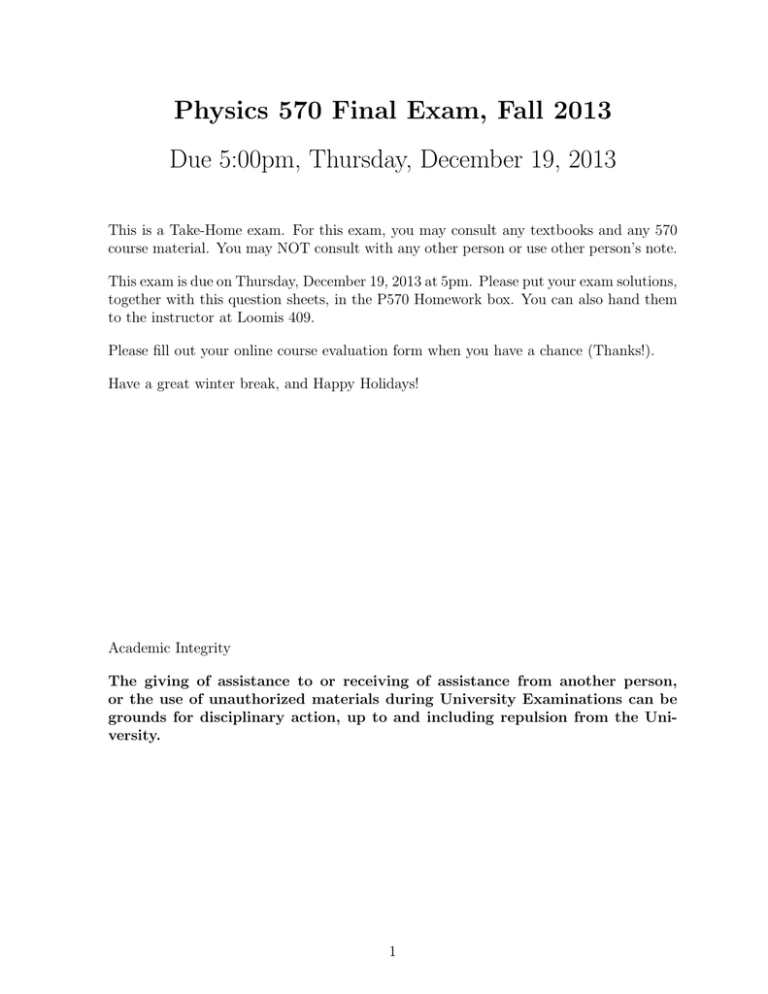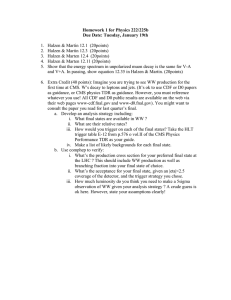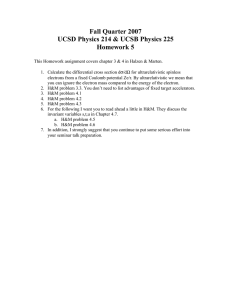Physics 570 Final Exam, Fall 2013 Due 5:00pm, Thursday
advertisement

Physics 570 Final Exam, Fall 2013 Due 5:00pm, Thursday, December 19, 2013 This is a Take-Home exam. For this exam, you may consult any textbooks and any 570 course material. You may NOT consult with any other person or use other person’s note. This exam is due on Thursday, December 19, 2013 at 5pm. Please put your exam solutions, together with this question sheets, in the P570 Homework box. You can also hand them to the instructor at Loomis 409. Please fill out your online course evaluation form when you have a chance (Thanks!). Have a great winter break, and Happy Holidays! Academic Integrity The giving of assistance to or receiving of assistance from another person, or the use of unauthorized materials during University Examinations can be grounds for disciplinary action, up to and including repulsion from the University. 1 Problem 1 (20 points) The angular distribution for the e+ e− → µ+ µ− process in the CM frame is 1+cos2 θ (Eq. 6.32 of Halzen and Martin). The related process, q̄q → γ ∗ → µ+ µ− , has the same angular distribution. If the quarks and antiquarks were spin-0 particles (but the muons are still spin-1/2 Dirac particles), what is the expression for the differential cross section? Ignore the masses of the quarks and muons in your derivations. This problem shows that one can determine the quark spin via the measurement of the angular distribution in this process. (You might find it useful to draw the Feynman diagram, and use the Feynman rules listed on page 149 of Halzen and Martin.). Problem 2 (20 points) Consider the decays π − → µ− ν̄µ and π − → e− ν̄e . Their decay rates have been derived in Section 12.6 of Halzen and Martin, and the ratio R, defined as R= Γ(π − → e− ν̄e ) , Γ(π − → µ− ν̄µ ) was also derived. These decays could also proceed via a pseudoscalar coupling for the hadronic current. The most general form of the matrix element is now (compare this with Eq. 12.46 of Halzen and Martin) G M = √ fπp ū(p) (1 + aγ 5 ) v(k), 2 where fπp is the pseudoscalar pion decay strength and a is a constant. The pseudoscalar coupling now favors the same helicity for lepton and antilepton. What is the value of R in this case? Comment on this result from the helicity consideration. The experimental value for R can be used to set a limit on the strength of the pseudoscalar coupling. 2 Problem 3 (15 points) Without working out the Feynman diagrams (unless you insist), what would be the polar angle dependence of the following reactions in the center-of-mass frame? Use the approach described on page 128 of Halzen and Martin. a) e− + e+ → γ ∗ → s− + s+ b) s− + s+ → γ ∗ → s− + s+ c) νe + ν̄e → Z 0 → νµ + ν̄µ s− and s+ are spin-0 point particles. Assume that the reactions occur at relativistic energies, and ignore the rest masses of the particles. Note that the relevant rotation matrices are given on page 39 of Halzen and Martin, reproduced below: d101 (θ) = −d110 (θ) = −d10−1 (θ) = d1−10 (θ) = q 1 2 sin θ d111 (θ) = d1−1−1 (θ) = 12 (1 + cos θ) d1−11 (θ) = d11−1 (θ) = 21 (1 − cos θ) d100 (θ) = cos θ Problem 4 (25 points) Neutral current was first discovered in a neutrino scattering experiment. For neutrino scattering off a nucleus having equal number of protons and neutrons (isoscalar nucleus), show that the ratios of neutral to charged-current cross sections are R= σ νN (NC) 1 20 = − sin2 θW + sin4 θW νN σ (CC) 2 27 R̄ = 1 20 4 σ ν̄N (NC) 2 = − sin θ + sin θW W σ ν̄N (CC) 2 9 and Neglect the sea quarks, as well as the interaction with the electrons. If the target is replaced by a hydrogen target, how would the ratios become? Assume u(x) = 2d(x) for the proton. 3 Problem 5 (20 points) State whether the following processes are possible or impossible, according to the Standard Model. If it is possible, state which interaction is primarily responsible (strong, electromagnetic, or weak). If it is only allowed by higher-order diagrams, state so. If it is not possible, explain why. a) K − + p → Λ + π 0 b) η → π + + π − c) K + → π + + π 0 d) Σ+ → n + e+ + νe e) K + + n → π + + Λ f) K + → π + + e+ + e− g) e+ + e− → ν + ν̄ h) ρ0 → π 0 + π 0 i) ν̄e + n → e− + p j) d + d → π 0 +4 He 4


